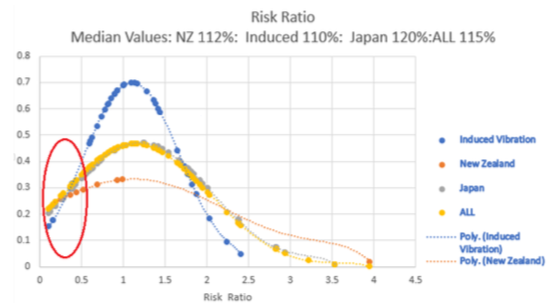Case Study – Wellington, New Zealand
City Uses Performance Measurements from Ambient Vibration to Identify Structural Risk Profile for 10 buildings
Measure the Performance. Determine the Stability. Understand the Risk
Project History
On November 14, 2016, Wellington, the Capital City in New Zealand, was impacted by the Kaikoura Earthquake, the second largest in their recorded history which occurred 100 Km to the south. The quake was a 7.8 magnitude event and impacted Wellington significantly by damaging many structures and the port area. The City experiences earthquakes regularly and sits on 4 major faults in one of the most seismically active regions in the world.
City Council’s Dilemma

The challenge for the City managers after an earthquake is to assess and repair damage so they can reoccupy buildings and try to get the City back to normal. In their efforts of assessing structures after Kaikoura, they hired high quality seismic engineers who followed proper code required methods to do the Structural Assessments on buildings. However, in some cases, the Assessment Reports for the same buildings prepared by different engineers had greatly varying results and recommendations. This created a serious concern for City managers since each Report has greatly varying required actions to be taken by the City. It became clear to City Managers that a less subjective and more accurate Structural Assessment method is needed in their case to add clarity and certainty to the process.
STRAAM’s Solution

The STRAAM Method uses the principles of structural dynamics and fracture mechanics to Measure the Performance, Determine the Stability and Understand the Risk of a structure. A week after the quake, STRAAM Group, and their licensed partner Mainmark were contracted to objectively measure the dynamic performance of ten City owned buildings and provide ten Structural Assessment Reports. The City was not aware that such a service existed prior to being approached by STRAAM, but saw the potential value that objective measurements could provide the City. STRAAM and Mainmark mobilized in a week and measured the performance of all ten structures in five days. The performance measurements capture the dynamic response of the buildings which include frequencies of resonance, mode shapes and non-linear damping response. Structures are always moving, in a well-designed building the occupants of the building will only feel the ‘sway’ of the building under extreme cases (very high wind or earthquakes). The three parameters above, frequencies of resonance, mode shapes and non-linear damping are simply the terms of art used to describe the rate of movement, how much it displaces. STRAAM’s proprietary technology have the required capabilities to measure the dynamic response from normal excitation from light wind or traffic.
STRAAM’s Results
The resulting reports provided a structure specific risk profile based on the measurements and highlighted weaknesses in the buildings. Building codes around the world, and in New Zealand, require certain levels of stiffness, strength and ductility for structural design. The building codes and standards try to protect against ‘severe structural weakness’, soft stories, dynamic sensitivity and many other conditions which can lead to failure. STRAAM’s methods gave objective clarity to these issues. The STRAAM Reports explained the unique dynamic characteristics of each structure and provided a detailed report explaining the structure’s performance in the context of the local building code.

After the risk profile was completed for all ten buildings, it was put into a ‘bell curve’ of structural risk. STRAAM has a database of 800 measured structures from around the world. Figure 3 is a bell curve of the risk profile created from each building’s measured response, where the Risk Ratio of 1 represents meeting the code’s requirement. We circled buildings in the data based with a Ratio of 0.5 since that reflects an elevated risk level. The Dynamic Assessment Reports and this comparison allowed City managers to see how each of the buildings performed relative to each other and to the other 800 buildings. With this approach, the poorest performers are quickly identified. This allowed the City managers to easily understand which buildings posed the greatest risk.
Added Value of STRAAM Method
For Wellington, and Cities around the world, these objective Dynamic Assessment Reports and the Risk Ratio performance comparison to other structures, can help City managers to make informed decisions regarding specific structures based on their objective and measured risk profile. The value of understanding the risk associated with each structure is in the ability to quickly determine where to allocate funds for repair and by having confidence that the building is ready for occupancy after each event. The aggregated information in the bell curve gives clear performance information relative to their own population of structures to pick out weak ‘outlier’ buildings. This database can be grown for each City to include assessments for all buildings in their inventory. An additional and long-term value of this objective assessment is to help very accurately quantify damage from future events. Once the ‘Baseline’ dynamic performance is established, then changes to this signature provide objective and actionable information relating to the new Risk Profile. Also, after a Baseline is completed, it is possible to install the technology for continuous monitoring with real-time performance information. This can provide real-time feedback regarding building performance and degradation.
Mr. Steven Cody, The City of Wellington’s Principal Advisor on Resilient Buildings, hired STRAAM Group and Mainmark. He said as STRAAM and Mainmark were hired, that ‘every time we get an earthquake, even if it’s minor, it takes a bite out of the building’s capacity. We need a way to better understand how the buildings are impacted’. He felt that objective measurements which relate to capacity could be a much-needed improvement to the current Structural Assessment methods, which after Kaikoura, proved to be quite subjective and left him in a difficult position regarding the recovery effort. He found the STRAAM Assessment Reports provided a critical data point regarding building performance and capacity. This helped him make important decisions regarding the recovery effort in Wellington.
(STRAAM’s methods are supported by 40 years of research conducted around the world and leverages advanced technology to quantify structural performance in order to better manage the old and new infrastructure. It puts the measured response into the context of existing building codes and compares the response to a unique data base of hundreds of measured buildings.)
This advanced approach represents a paradigm shift in understanding structural performance. It helps identify structural risk for all stake holders and is needed for community resilience and public safety.

